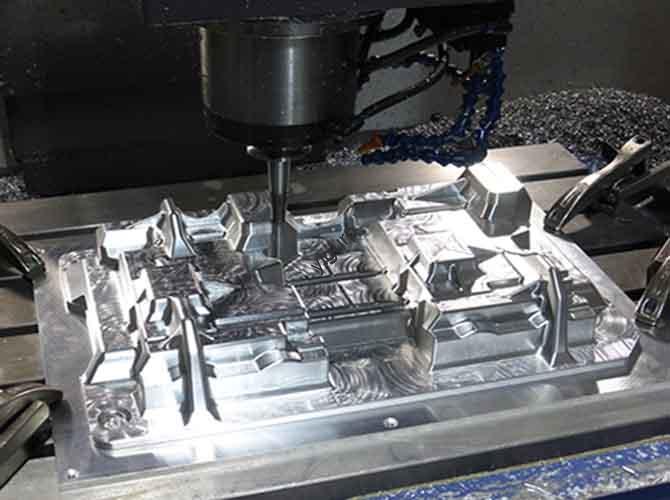Choisir le bon matériau pour moules prototypes en plastique impacte directement la durabilité du moule, vitesse de production, précision, et coûter. Il n'existe pas d'option « taille unique » : les matériaux varient en fonction des besoins du projet, comme quantité de production, complexité en partie, exigences de précision, et budget. Cet article détaille les matériaux les plus courants, leurs avantages et leurs inconvénients, cas d'utilisation, et un guide étape par étape pour sélectionner la meilleure solution.
1. Matériaux courants pour les moules prototypes en plastique (Table de comparaison)
Below is a comprehensive overview of 6 matériaux largement utilisés, including their key traits and application scenarios:
| Catégorie de matériel | Specific Types | Avantages clés | Inconvénients principaux | Scénarios d'application idéaux |
| Alliage en aluminium | 6061, 7075 | – Léger (facile à manipuler) – Excellente machinabilité (production rapide) – Bonne conductivité thermique (faster cooling for parts) | – Faible dureté (wears quickly) – Not suitable for high-volume production | Small/medium-sized prototypes, trial samples, pièces d'apparence (Par exemple, Prototypes de cas de téléphone) |
| Acier | P20, H13, 45# Acier | – Dureté élevée (à l'usure) – Suitable for medium/large molds – Résistant à la chaleur (works with thermoplastics) | – Lourd (hard to transport/operate) – Long processing cycle – Coût élevé | Parties fonctionnelles, complex-structure prototypes, high-volume production molds (Par exemple, automotive component molds) |
| Bakélite (Phénolique) | Phenolic resin-based | – Faible coût (budget-friendly) – Facile à traiter (fast mold making) | – Faible résistance (prone to breakage) – Mauvaise résistance à l'usure – Basse précision | Low-precision, petit lot, prototypes non fonctionnels (Par exemple, simple shape test parts) |
| Epoxy/Polyurethane Resin | Résine époxy, polyuréthane | – Prototypage rapide (durcissement rapide) – Suitable for soft molds – Low cost for small batches | – Faible résistance (not durable) – Not for high-precision or long-term use | Simple-shape prototypes, exterior parts, temporary molds (Par exemple, short-term trial production molds) |
| Copper/Beryllium Copper Alloy | Cuivre pur, cuivre au béryllium | – Excellente conductivité thermique (fast part cooling) – Good precision retention | – Coût élevé (expensive material) – Difficult to process (needs specialized tools) | Pièces à parois minces, composants de précision, molds requiring fast cooling (Par exemple, high-precision electronic part molds) |
| 3D Matériaux d'impression | Résine photosensible, nylon | – No traditional machining needed (direct 3D printing) – Ideal for complex shapes – Fast prototyping for small batches | – Limited strength (pas résistant à l'usure) – Not suitable for high-volume production | Complex-shape prototypes, small-batch rapid molds (Par exemple, intricate medical device prototype molds) |
2. Facteurs clés à prendre en compte lors de la sélection des matériaux
To avoid 选错 materials (and wasting time/money), follow this 4-step, cause-effect driven guide—each factor directly influences your material choice:
Étape 1: Définir la quantité de production
- Petits lots (1–50 pièces): Choisir alliage en aluminium, résine époxy, ou 3D Matériaux d'impression (production rapide, faible coût).
- Gros lots (500+ parties): Opter pour acier (à l'usure, durable enough for repeated use).
- Lots moyens (50–500 pièces): Balance with alliage en aluminium (if precision needs are moderate) ou low-cost steel (if durability is critical).
Étape 2: Évaluer les exigences de précision
- Haute précision (±0.01mm or tighter): Utiliser acier (stable dimension retention) ou copper/beryllium copper alloy (excellent precision for small parts).
- Moderate precision (± 0,1 mm): Alliage en aluminium ou 3D printing with photosensitive resin fonctionne bien.
- Basse précision (± 1 mm): Bakélite ou résine époxy is sufficient (budget-friendly).
Étape 3: Evaluate Budget Constraints
- Petit budget: Prioriser bakelite, résine époxy, ou entry-level 3D printing materials (nylon/PLA-based).
- Medium budget: Alliage en aluminium (équilibre les coûts et les performances) est le meilleur choix.
- À budget élevé: Investir dans acier (pour la durabilité) ou beryllium copper alloy (for high precision and cooling speed).
Étape 4: Analyze Part Complexity
- Formes complexes (Par exemple, creux internes, détails fins): 3D Matériaux d'impression (no need for traditional machining) ou alliage en aluminium (easy to mill complex features).
- Formes simples (Par exemple, panneaux plats, basic frames): Bakélite, résine époxy, ou low-cost steel (traitement rapide, no extra complexity).
3. Perspective de la technologie Yigu
À la technologie Yigu, we believe plastic prototype mold material selection is a “balance of needs” rather than chasing a single “best material.” For most clients—especially startups and small businesses—alliage en aluminium (6061) is the most versatile choice: it’s fast to machine, rentable, and precise enough for 80% of prototype needs. Pour les projets de haute précision (Par exemple, prototypes de dispositifs médicaux), Nous recommandons beryllium copper alloy for its cooling speed and precision retention. For budget-limited, simple tests, 3D printed photosensitive resin molds cut lead time by 50% compared to traditional materials. Notre conseil: Start by listing your top 2 priorities (Par exemple, “speed + low cost” or “precision + durability”)—this narrows down materials in minutes.
4. FAQ (Questions fréquemment posées)
- Q: Can I use 3D printing materials for plastic prototype molds that need to produce 100 parties?
UN: Cela dépend du matériau. Résine photosensible molds are only suitable for 10–20 parts (low wear resistance), mais nylon-based 3D printing materials can handle 50–80 parts. Pour 100 parties, Nous recommandons alliage en aluminium (more durable and cost-effective).
- Q: Is steel always better than aluminum alloy for plastic prototype molds?
UN: Non. Steel is better for high-volume, high-wear scenarios, but aluminum alloy is superior for small batches: it’s 3x faster to machine, 1/3 the weight, et 50% moins cher. Choose steel only if you need 500+ parts or extreme durability.
- Q: Why is beryllium copper alloy used for thin-walled plastic parts?
UN: C'est Excellente conductivité thermique (2x higher than aluminum) ensures thin-walled parts cool quickly and evenly, reducing warping or deformation. This is critical for thin parts (Par exemple, 0.5mm thick electronic casings) where shape accuracy is key.
